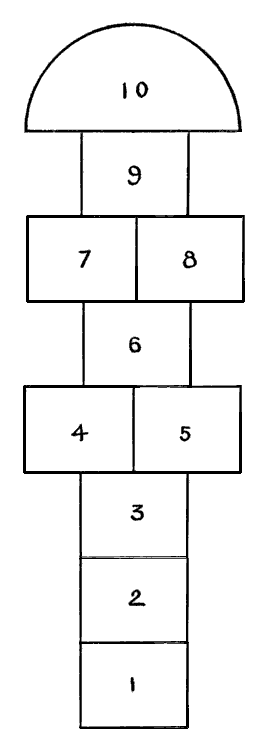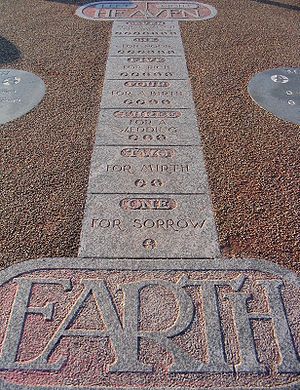 Image via WikipediaThis traditional game of "Piko" or "Hopscotch" is among the popular streetgames during my early age in 80's. Usually played by girls in elementary school or after the school in streets. I remember almost all of my girl classmates playing "piko" during recess or break-time, while some of us are busy in playing other traditional games like "agawan base", "sipa", "teks", "goma" and many others depending what is "in" (uso) that time. Even me and some boys have tried this kind of game and its enjoyable. After school, some students still playing this game for hour before going home. In street, its a common scene to see small girls playing this kind of game like my sisters and girl friends. This is how much popular "piko" or hopscotch during 80's.
Image via WikipediaThis traditional game of "Piko" or "Hopscotch" is among the popular streetgames during my early age in 80's. Usually played by girls in elementary school or after the school in streets. I remember almost all of my girl classmates playing "piko" during recess or break-time, while some of us are busy in playing other traditional games like "agawan base", "sipa", "teks", "goma" and many others depending what is "in" (uso) that time. Even me and some boys have tried this kind of game and its enjoyable. After school, some students still playing this game for hour before going home. In street, its a common scene to see small girls playing this kind of game like my sisters and girl friends. This is how much popular "piko" or hopscotch during 80's.Playing "piko" is very simple. All you need to have is marker usually "chalk"or "crayola" or anything than can be use to draw lines in the concrete ground. Some plays in plain ground, a sandy loam soil, and draws the mark using a stick. You need also a "pamato" or pucks for this game, this is usually a flat stone or part of broken pot.
The mechanics for this game is easy and can be played by single or by group. By group, it should be started by finding out who will play first usually by jack-en-poy. The first step is by throwing your pucks in 1st box then jumping with one leg for 2nd and 3rd box, with left leg on 4rth box and right leg on 5th box, one leg on 6th box, with left leg on 7th box and right leg on 8th box, one leg in 9th box, and two legs on 10th box. In the 10th box you need to make pivot and repeat the process going back, making a pause in 2nd box while getting your pucks in 1st box by bending your body down with single leg then jumping out of the box. The next steps is throwing your pucks in 2nd box up to 10th box and follow the same procedure in first step. If the player's pucks or her body touches the line, it will be a turn for another player. The one to complete until 10th box will declare winner of this game.
Other variation of this game is done by the player looking towards the sky then throwing his marker on the diagram. Without looking, he must walk across the diagram to fetch his marker without touching any lines. This stage is intentionally more difficult to give the other players a chance to catch up.
This traditional game is not only popular in the Philippines before but also in many parts of the world but the rules and mechanics varies on locations. It is thought that the origin maybe from Romans or Chinese. The earliest record was in 1677 in Poor Robins Almanack with the name "Scotch-hoppers". In India it is called "Stapu or "Kith-kith", "Rayuela" in Spain, "Golosa" in Latin America, "Knaccuku" in Russia, "Klasy" in Poland, "Camapana"or "Mondo" in Italy, "Hinkelen" in Netherlands and Flanders, "Skolica" in Bosnia, Croatia, and Serbia. "Tengteng" in Malaysia, "Bebeleche" in Mexico, "Peregrina" in Puerto Rico, "Soton" in Romania, "Amarelinha" in Brazil, "Escargot or "La Marelle Ronde" in France, "Rrasavi" in Albania, "Potsy" in New York, "Laylay" in Iran, and "Himmel und Hölle" in Germany, Austria and Switzerland.
 |
| Image Source young boy playing piko |
 |
| Image Source player of piko touching the box line |
 |
| Image Source teaching piko to the youth to revived traditional games in Philippines |
 Image via Wikipedia Image via Wikipedia |
| Girls in Cuba Playing Hopscotch |
 Image via Wikipedia Image via Wikipedia |
| Girls playing Hopscotch in Jaura, M.P. India |
 Image via Wikipedia Image via Wikipedia |
| A hopscotch game in Boston USA |
 Image via Wikipedia Image via Wikipedia |
| A traditional hopscotch game with a magpie rhyme in Morcambe , England |

No comments:
Post a Comment